Question
(a) Fig. 1.1 is a diagram of the human gas exchange system.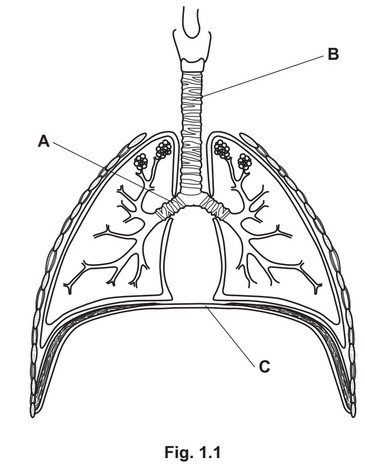
(i) Identify the structures labelled A, B and C in Fig. 1.1.
A ……………………………………………………………………………………………………………………….
B ……………………………………………………………………………………………………………………….
C ……………………………………………………………………………………………………………………….
(ii) Explain how the structures in the gas exchange system cause inspiration.
(b) A person who does not smoke can be exposed to tobacco smoke from other people smoking.
Researchers studied the effect of exposure to tobacco smoke on the development of lung
cancer in three groups of women who did not smoke:
• group 1 – no exposure to tobacco smoke
• group 2 – low level exposure to tobacco smoke
• group 3 – high level exposure to tobacco smoke.
Their results are shown in Table 1.1.
(i) Calculate the percentage of women in group 2 who died from lung cancer.
Write your answer, to two significant figures, in Table 1.1.
(ii) Many countries have laws that ban smoking in public buildings.
Discuss the evidence from Table 1.1 that supports these laws.
(iii) Smoking has been found to increase the risk of developing diseases other than cancer.
State two other diseases that can be caused by smoking.
1 ……………………………………………………………………………………………………………………….
2 ……………………………………………………………………………………………………………………….
Answer/Explanation
Answer:
(a)
(i) A – bronchus ;
B – trachea ;
C – diaphragm ;
(ii) 1 diaphragm, contracts / flattens ;
2 external intercostal muscles contract ;
3 ribs move, upwards / outwards ;
4 volume, increases ;
5 pressure, decreases ;
6 air enters (the, mouth / trachea / lungs,) to equalise the
pressure ;
(b) (ii)
86 / 44184 × 100 = 0.194 ; 0.19 (%) ;
(ii)
idea that non-smokers / passive smokers / AW, can die from / can develop lung cancer ;
the greater the exposure to tobacco smoke the greater the risk (of
dying from lung cancer) ;
comparative data quote ;
(iii)
COPD ;
CHD ;
AVP ;;
Question
The gas exchange system is one of the organ systems of the human body.
Fig. 1.1 shows parts of the gas exchange system during breathing in and breathing out.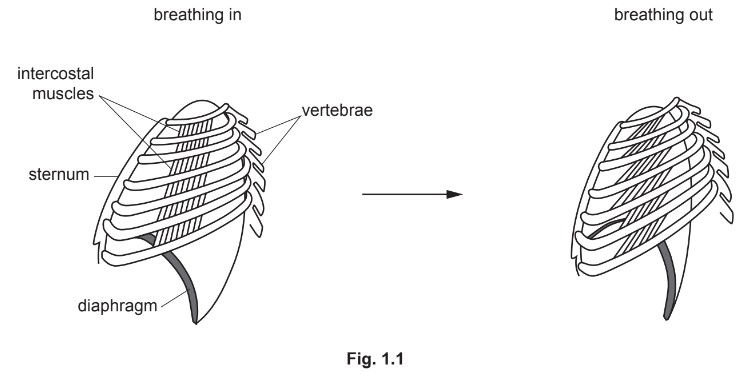
(a) Complete Table 1.1 to show:
• the functions of the diaphragm and the intercostal muscles during breathing in and
breathing out
• the pressure changes in the thorax.
Use these words:
contract
relax
increases
decreases.
Fig. 1.2 shows part of the gas exchange surface of a human.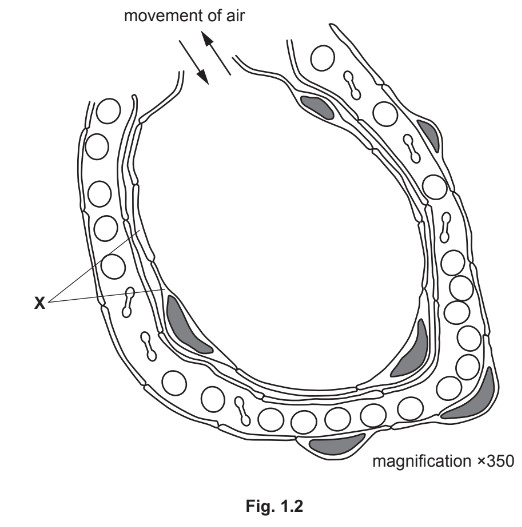
(b) (b) State two features of the gas exchange surface that are visible in Fig. 1.2.
1 ………………………………………………………………………………………………………………………………
2 ………………………………………………………………………………………………………………………………
(c) The cells labelled X on Fig. 1.2 form a tissue.
(i) Define the term tissue.
(ii) Cartilage is another tissue found in the gas exchange system.
State the functions of cartilage in the gas exchange system.
Answer/Explanation
Answer:
(a) one mark for each column:
(b) any two from:
thin / short distance (for diffusion) ;
well supplied by blood / surrounded by capillaries / AW ;
good ventilation with air ;
(c) (i) a group of cells with similar structures ;
working together to perform a shared function ;
(ii)
any two from:
forms incomplete rings around, trachea / bronchi ;
keeps (named) airways open ;
reduces resistance to movement of air ;
protects (named) airways ;
sound production in larynx ;
Question
The gas exc hange system is one of the organ systems of the human body.
Fig. 1.1 shows parts of the gas exchange system during breathing in and breathing out.
(a) Complete Table 1.1 to show:
• the functions of the diaphragm and the intercostal muscles during breathing in and
breathing out
• the pressure changes in the thorax.
Use these words:
contract
relax
increases
decreases.
Fig. 1.2 shows part of the gas exchange surface of a human.
(b) (b) State two features of the gas exchange surface that are visible in Fig. 1.2.
1 ………………………………………………………………………………………………………………………………
2 ………………………………………………………………………………………………………………………………
(c) The cells labelled X on Fig. 1.2 form a tissue.
(i) Define the term tissue.
(ii) Cartilage is another tissue found in the gas exchange system.
State the functions of cartilage in the gas exchange system.
Answer/Explanation
Answer:
(a) one mark for each column:
(b) any two from:
thin / short distance (for diffusion) ;
well supplied by blood / surrounded by capillaries / AW ;
good ventilation with air ;
(c) (i) a group of cells with similar structures ;
working together to perform a shared function ;
(ii)
any two from:
forms incomplete rings around, trachea / bronchi ;
keeps (named) airways open ;
reduces resistance to movement of air ;
protects (named) airways ;
sound production in larynx ;
Question
(a) Fig. 3.1 shows some of the structures present in the human thorax (chest). Identify the structures labelled P, Q, R and S. Write your answers in the boxes on Fig. 3.1.
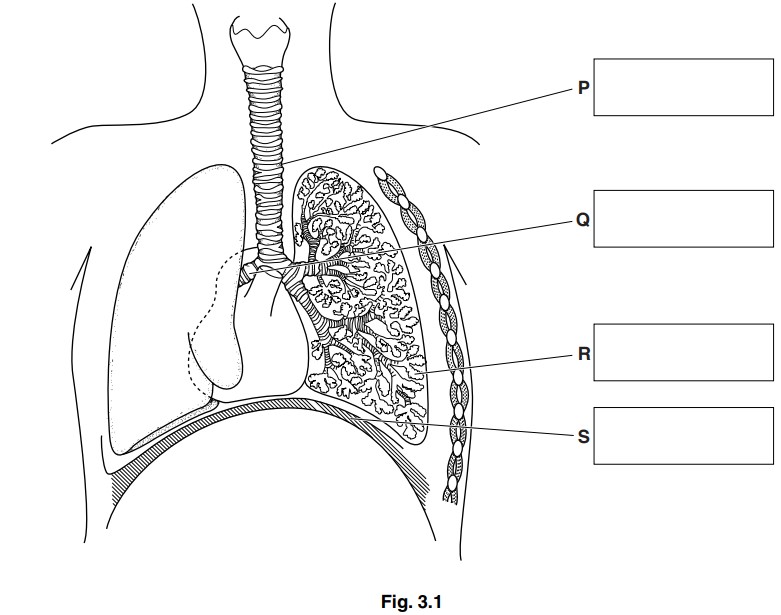
(b) Table 3.1 shows the composition of inspired (inhaled) and expired (exhaled) air.

(i) Expired air has more carbon dioxide then inspired air. Approximately how many times greater was the percentage of carbon dioxide in the expired air than in the inspired air? Choose your answer from this list.
×1.3 ×13 ×130 ×1300
(ii) There is no difference in the nitrogen content of inspired and expired air. Suggest a reason for this.
………………………………………………………………………………………………………………………….
………………………………………………………………………………………………………………………….
(iii) Expired air often contains more water vapour than inspired air. Explain how this water vapour gets into the expired air.
………………………………………………………………………………………………………………………….
………………………………………………………………………………………………………………………….
………………………………………………………………………………………………………………………….
…………………………………………………………………………………………………………………………
(c) Table 3.2 shows the effects of exercise on the rate of oxygen uptake and the rate of energy use.
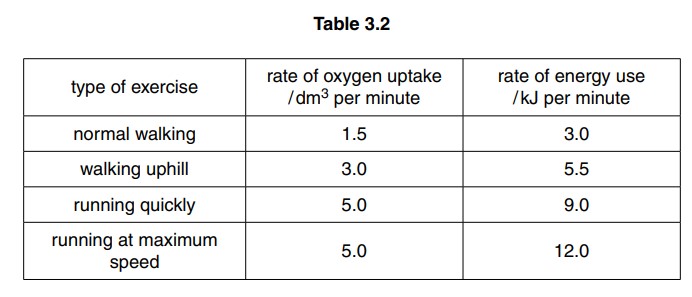
(i) Describe what happens to the rate of oxygen uptake as activity increases.
………………………………………………………………………………………………………………………….
………………………………………………………………………………………………………………………….
………………………………………………………………………………………………………………………….
………………………………………………………………………………………………………………………….
(ii) Use the results in Table 3.2 to calculate how many kilojoules of energy are needed to run quickly for 12 minutes.
………………………………………………………………kJ
(iii) 1 g of sugar provides about 18.0 kJ of energy. Calculate how much sugar would be needed to run at maximum speed for 30 seconds. Show your working.
………………………………………………………………g
Answer/Explanation
Ans:
3. (a) P trachea/windpipe;
Q bronchus / cartilage ring;
R air sac /alveolus;
S diaphragm;
(b) (i) x 130;
(ii) nitrogen is not used up/ produced by (the cells of) the body;
(iii) air sacs / alveoli have a moist lining;
water evaporates (from lining into air);
water (in lining) replaced by osmosis from cells (of alveoli)/AW;
(c) (i) (oxygen uptake) increases;
reaches a maximum;
specific reference to figures in table;
(ii) (12 × 9 =) 108 (kJ);
(iii) 30/ 60× 12 = 6;
6/ 18 = 0.33;
Question
(a) Fig. 3.1 shows some of the structures present in the human thorax (chest). Identify the structures labelled P, Q, R and S. Write your answers in the boxes on Fig. 3.1.

(b) Table 3.1 shows the composition of inspired (inhaled) and expired (exhaled) air.

(i) Expired air has more carbon dioxide then inspired air. Approximately how many times greater was the percentage of carbon dioxide in the expired air than in the inspired air? Choose your answer from this list.
×1.3 ×13 ×130 ×1300
(ii) There is no difference in the nitrogen content of inspired and expired air. Suggest a reason for this.
………………………………………………………………………………………………………………………….
………………………………………………………………………………………………………………………….
(iii) Expired air often contains more water vapour than inspired air. Explain how this water vapour gets into the expired air.
………………………………………………………………………………………………………………………….
………………………………………………………………………………………………………………………….
………………………………………………………………………………………………………………………….
…………………………………………………………………………………………………………………………
(c) Table 3.2 shows the effects of exercise on the rate of oxygen uptake and the rate of energy use.

(i) Describe what happens to the rate of oxygen uptake as activity increases.
………………………………………………………………………………………………………………………….
………………………………………………………………………………………………………………………….
………………………………………………………………………………………………………………………….
………………………………………………………………………………………………………………………….
(ii) Use the results in Table 3.2 to calculate how many kilojoules of energy are needed to run quickly for 12 minutes.
………………………………………………………………kJ
(iii) 1 g of sugar provides about 18.0 kJ of energy. Calculate how much sugar would be needed to run at maximum speed for 30 seconds. Show your working.
………………………………………………………………g
Answer/Explanation
Ans:
3. (a) P trachea/windpipe;
Q bronchus / cartilage ring;
R air sac /alveolus;
S diaphragm;
(b) (i) x 130;
(ii) nitrogen is not used up/ produced by (the cells of) the body;
(iii) air sacs / alveoli have a moist lining;
water evaporates (from lining into air);
water (in lining) replaced by osmosis from cells (of alveoli)/AW;
(c) (i) (oxygen uptake) increases;
reaches a maximum;
specific reference to figures in table;
(ii) (12 × 9 =) 108 (kJ);
(iii) 30/ 60× 12 = 6;
6/ 18 = 0.33;
Question
Fig. 1.1 shows a woodlouse.
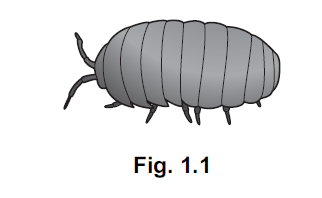
The woodlouse is a crustacean, one of the four groups of arthropod.
It is a herbivore that lives on land and eats decaying plant materials.
It breathes with gills that must be kept moist.
(a) Name two other groups of arthropod.
For each group state one feature found only in animals of that group.

(b) Some students were sent to find woodlice for an investigation.
Suggest and explain two reasons why populations of woodlice are usually found under
stones, decaying wood and leaves.
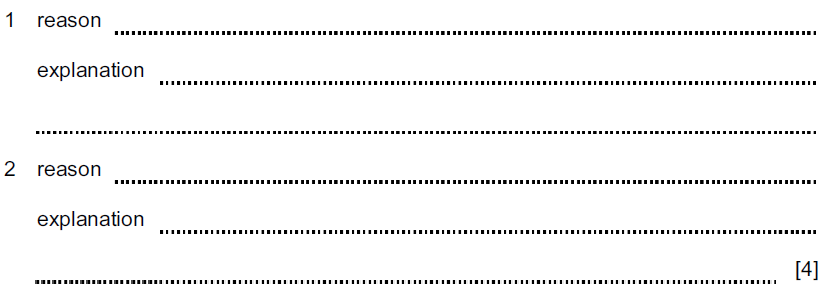
Answer/Explanation
Ans:
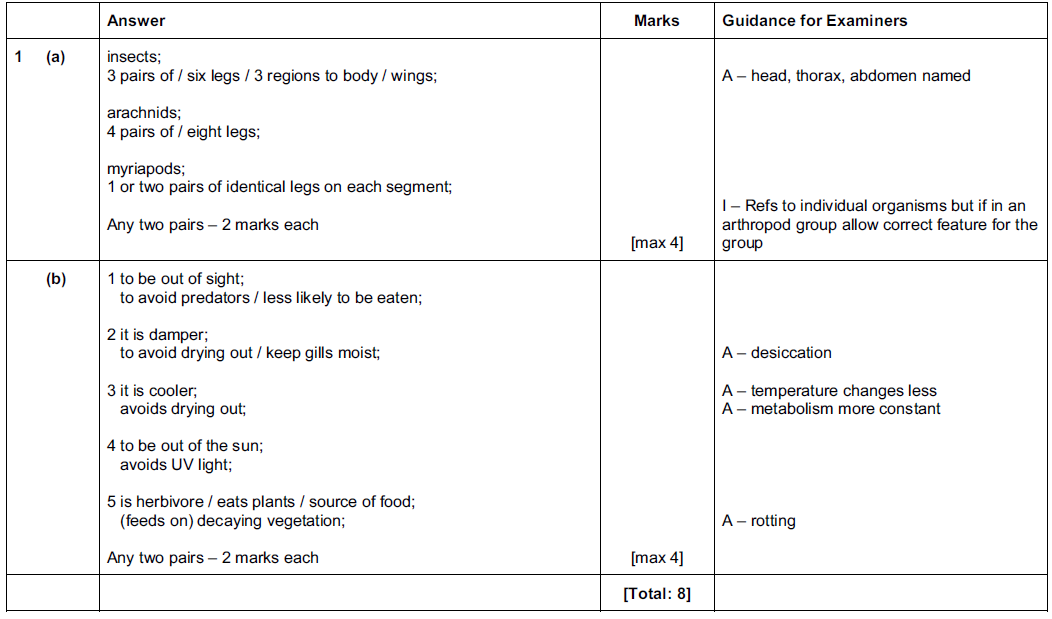
Question
(a) (i) State the name of the gas exchange surface in humans.
…………………………………………………………………………………………………………………….
(ii) State two features of the gas exchange surface in humans.
1 ……………………………………………………………………………………………………………………….
2 ……………………………………………………………………………………………………………………….
(b) Fig. 1.1 is a diagram of the gas exchange system in humans.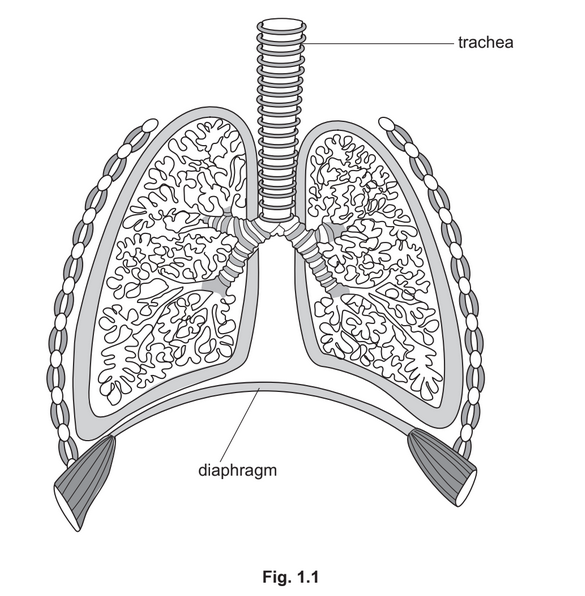
(i) Draw a label line and the letter X on Fig. 1.1 to identify an external intercostal muscle.
(ii) State the name of the tissue that forms C-shaped structures in the wall of the trachea
and state its function.
name …………………………………………………………………………………………………………………
function ………………………………………………………………………………………………………………
………………………………………………………………………………………………………………………….
(iii) Describe the effects on the thorax of contraction of the diaphragm.
………………………………………………………………………………………………………………………….
………………………………………………………………………………………………………………………….
………………………………………………………………………………………………………………………….
………………………………………………………………………………………………………………………….
…………………………………………………………………………………………………………………….
(c) Table 1.1 compares the composition of inspired and expired air.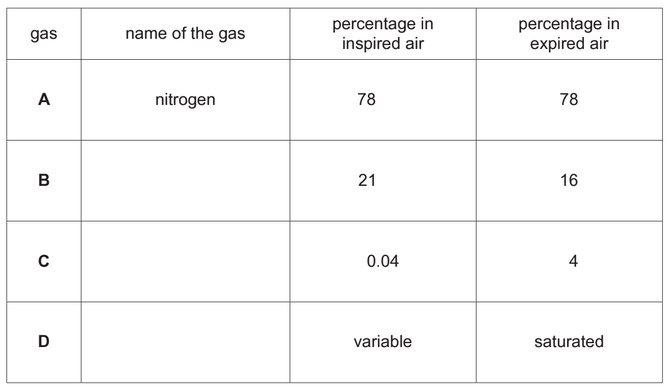
(i) Complete Table 1.1 by writing the names of gases B, C and D.
(ii) For gas B and gas C, explain the differences in the percentages shown in Table 1.1
between inspired and expired air.
Answer/Explanation
Ans
(a)(i) alveoli/alveolus ;
(ii) any two from :
large surface area ;
thin surface / short diffusion distance ;
good blood supply ;
good ventilation (with air ) ;
AVP ;
(b) (i) correct label line with the label X to the intercostal muscle ;
(ii) name cartilage ;
function support/prevent collapse/ allows movement of air ;
(iii) increases in volume ;
decreases in pressure ;
(c)(i) B oxygen
C carbon dioxide ;
D water vapour ;
(ii) ref. to (aerobic) respiration ;
B/ oxygen, is a reactant of respiration / diffuses across alveoli / into cells or blood;
C / carbon dioxide, is a product of respiration / diffuses across alveoli/ out of cells or blood ;
Question
A group of students planned an investigation to determine the effects of physical activity on breathing rate.
(a) Describe how the students could measure their breathing rates.
…………………………………………………………………………………………………………………………………
…………………………………………………………………………………………………………………………………
………………………………………………………………………………………………………………………………..
(b) The students measured their breathing rates before physical activity and every minute for
five minutes after cycling around the school field.
Write a hypothesis for their investigation.
…………………………………………………………………………………………………………………………………
…………………………………………………………………………………………………………………………………
…………………………………………………………………………………………………………………………………
(c) Fig. 2.1 shows a woman on a stationary bicycle. The mask fitted over her nose and mouth measures the composition of the air she breathes out.

Fig. 2.2 shows the concentration of carbon dioxide in the air expired by the woman in the five minutes after she stopped exercising.
The dashed line on the graph shows the concentration of carbon dioxide in her expired air when she was at rest, before she began to exercise.
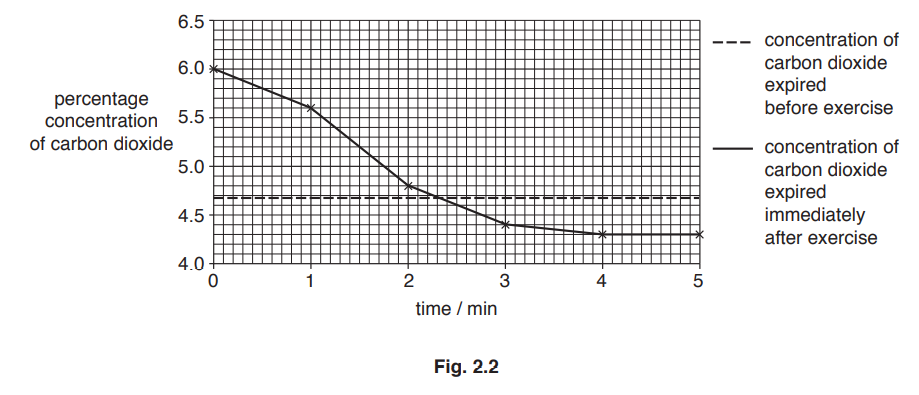
Describe and explain the results of the investigation shown in Fig. 2.2.
Use the data in Fig. 2.2 in your answer.
…………………………………………………………………………………………………………………………………
…………………………………………………………………………………………………………………………………
…………………………………………………………………………………………………………………………………
…………………………………………………………………………………………………………………………………
…………………………………………………………………………………………………………………………………
(d) Before starting the investigation, the researchers confirmed that the woman did not have
coronary heart disease.
(i) Suggest why.
………………………………………………………………………………………………………………………….
…………………………………………………………………………………………………………………………
(ii) Explain why exercise is recommended for people with a high risk of developing coronary heart disease.
………………………………………………………………………………………………………………………….
………………………………………………………………………………………………………………………….
………………………………………………………………………………………………………………………….
………………………………………………………………………………………………………………………….
………………………………………………………………………………………………………………………….
………………………………………………………………………………………………………………………….
………………………………………………………………………………………………………………………….
▶️Answer/Explanation
Ans:
(a)40
watch chest / abdomen, rise and fall / use a spirometer ;
ref. to time / in one minute ;
(b)
exercise will increase breathing rate ;
after exercise the breathing rate, will start decreasing / levels off ;
(c)
description
carbon dioxide constant / at 4.7% , before exercise ;
carbon dioxide highest / higher, at 6.0% / (immediately) after exercise ;
decreases;
falls below resting level / AW ;
comparative data quote ;
explanation
removal of excess carbon dioxide ;
more energy used during exercise means higher rates of respiration ;
aerobic respiration releases carbon dioxide ;
oxygen not supplied fast enough (from lung / heart) / more oxygen required by
muscles ;
oxygen debt ;
anaerobic respiration (in muscles) ;
(produces) lactic acid / lactate;
lactic acid is, broken down / respired / converted to glucose / converted to
carbon dioxide ;
(d)(i)
safety risk (not to over exercise) ;
CHD could change the expected result (for healthy people) ;
she does not show (named) risk factor ;
(d)(ii)
prevents blocked arteries / prevents thrombus formation ;
lowers blood pressure ;
lowers cholesterol / lowers fats / reduces risk of atheroma ;
weight loss / using fats / avoids obesity ;
lowers stress ;
(heart) muscle stronger / lower (resting) pulse ;
